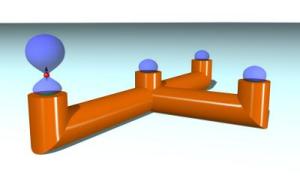Jun 26 2014
The magnetic hose designed by the researchers consists of a ferromagnetic cylinder covered by a superconductor material, a surprisingly simple design given the complicated theoretical calculations and numerous lab tests it had to undergo.
A 14-centimeter prototype was built, which transports the magnetic field from one extreme to the other with a efficiency of 400% in comparison to current methods used to transport these fields.
 This is a schematic representation of the magnetic hose. The magnetic field generated at the hose inlet is transmeted to the outlets. Credit: UAB
This is a schematic representation of the magnetic hose. The magnetic field generated at the hose inlet is transmeted to the outlets. Credit: UAB
Even with the efficiency of the prototype, researchers theoretically demonstrated that the magnetic hose can be even more efficient if the ferromagnetic tube is covered with thin layers of alternating superconductor and ferromagnetic material.
The device designed by the researchers can be implemented at any scale, even at nanometre scale. Thus, a magnetic nanohose capable of individually controlling quantum systems could help to solve some of the current technological problems existing in quantum computing.
Magnetic Fields Guided by New Technology
Magnetism is a basic element of today's technology, such as in energy generating processes and in the storage of information in computers. And one of the essential processes in these technologies is the conduct and transfer of magnetic fields, either with the use of large transformers or in logic nanodevices.
Light, formed by magnetic and electric field waves, can be very effectively conducted through optical fibres. Nevertheless, "until now there was nothing similar with which to guide and transport static magnetic fields," explains Àlvar Sánchez, ICREA Academia and leader of the research. "To guide these fields in electronic circuits or in current transformers, ferromagnetic materials such as iron alloys are used, but their intensity quickly drops with the distance and their application is limited."